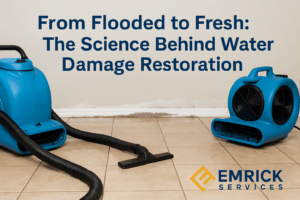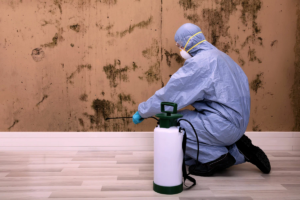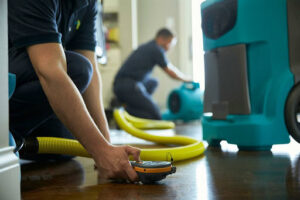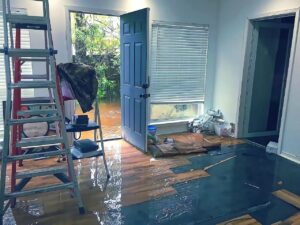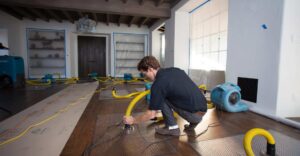In the wake of water damage, the aftermath can be devastating. Not only does it leave you with the hassle of dealing with repairs and restoration, but it also takes a toll on your belongings and the structural integrity of your home. Understanding the impacts of water damage is essential for taking the necessary steps to protect what matters most.
When water wreaks havoc in your home, it can ruin a wide range of items and areas. In this article, we’ll explore the specific belongings and home components that are most susceptible to water damage, as well as the long-term consequences and health risks associated with it. By identifying these vulnerable areas, you can take proactive measures to safeguard your property and minimize the risk of ruin.
Key Takeaways:
- Water damage can have a devastating impact on your belongings and the structural integrity of your home.
- Specific belongings prone to water damage include furniture, electronics, documents, and sentimental items.
- The aftermath of water damage can lead to long-term consequences such as mold growth and health risks.
- Protecting your belongings and taking preventive measures is crucial in mitigating the effects of water damage.
- Maintaining a safe living environment requires understanding the destructive power of water and being proactive in prevention.
Understanding the Destructive Power of Water
Before delving into what gets ruined in water damage, it’s important to understand the destructive power of water and the various causes of water damage.
Water, while essential for life, can also be incredibly destructive. Its power to damage property and belongings should never be underestimated. Water damage can occur in various ways, and understanding the causes can help you take preventive measures and mitigate the risks.
The Destructive Force of Water
Water possesses immense force, capable of eroding landscapes and crumbling structures. Its destructive power is evident in natural disasters like floods, hurricanes, and storms, where it can wipe out entire communities and leave a trail of destruction in its wake.
Even on a smaller scale, water’s force can still wreak havoc. A burst pipe, leaking roof, or overflowing toilet can quickly turn a once calm and peaceful home into a disaster zone. The speed at which water can spread and penetrate porous surfaces is astonishing and can cause irreparable damage in a matter of minutes.
Understanding the potential damage caused by water is crucial for homeowners. By being aware of the risks and taking appropriate preventive measures, you can safeguard your property and minimize the devastating effects.
Common Causes of Water Damage
Water damage can result from a variety of sources, each with its unique destructive capabilities:
- Plumbing issues: Faulty pipes, burst water lines, or leaking fixtures can cause significant water damage within your home.
- Natural disasters: Heavy rain, flooding, hurricanes, and storms can lead to severe water damage.
- Roof leaks: Damaged or improperly installed roofs can allow water to seep into your home, causing extensive damage to ceilings, walls, and furnishings.
- Appliance malfunctions: Issues with appliances like washing machines, dishwashers, or water heaters can result in water leakage and subsequent damage.
- Foundation cracks: Cracks in the foundation can allow water to enter your home, causing structural damage and potential flooding.
By identifying the common causes of water damage, you can take proactive steps to prevent or address these issues before they lead to costly and disruptive consequences.
| Causes of Water Damage | Impact |
|---|---|
| Plumbing issues | Water leakage, damage to walls, ceilings, and floors, mold growth |
| Natural disasters | Flooding, destruction of property, potential health hazards |
| Roof leaks | Damage to ceilings, walls, and furnishings, mold growth |
| Appliance malfunctions | Water damage to floors, surrounding areas, and belongings |
| Foundation cracks | Structural damage, potential flooding, compromised stability |
Belongings Prone to Water Damage
When water damage occurs in your home, certain belongings are more susceptible to destruction. Understanding which items are at risk can help you take proactive measures to protect them.
Furniture: Upholstered furniture, such as sofas and mattresses, can absorb water quickly and become a breeding ground for mold and bacteria. Wooden furniture can warp and become damaged when exposed to moisture for prolonged periods.
Electronics: Electronics, including televisions, computers, and smartphones, are highly sensitive to water damage. Even a small amount of moisture can cause irreversible harm to circuit boards and other components.
Documents: Important documents like passports, birth certificates, and legal papers are easily ruined by water. Water can cause ink to bleed and paper to become soggy, making the documents illegible and unsalvageable.
Sentimental Items: Sentimental items, such as photographs, artwork, and heirlooms, hold immense personal value. They are often irreplaceable and can be severely damaged by water, leading to the loss of cherished memories.
To protect your belongings from water damage, consider the following preventive measures:
- Place furniture on risers or waterproof mats to protect them from potential leaks or flooding.
- Keep electronics away from areas prone to water exposure, such as basements or bathrooms.
- Store important documents in waterproof containers or safely digitize them for added security.
- Take photographs of sentimental items and store digital copies in the cloud or on external hard drives.
By taking these precautionary steps, you can minimize the risk of water damage to your belongings and preserve them for years to come.
Structural Damage and Home Components Affected
When water infiltrates your home, it can cause significant structural damage, compromising the stability and integrity of various components. From the foundation to the walls, flooring, and insulation, no area is immune to the destructive impact of water damage.
Let’s take a closer look at the specific home components that are most susceptible to water damage:
- Foundation: Water seepage can weaken the foundation, causing cracks and shifting.
- Walls: Moisture in the walls can lead to rot, mold growth, and structural instability.
- Flooring: Wooden floors can warp, buckle, or become permanently damaged. Carpeting may develop mold and require complete replacement.
- Insulation: Wet insulation loses its effectiveness and can create an environment for mold and mildew to thrive.
- Electrical and Plumbing Systems: Water damage can pose a serious risk to electrical and plumbing systems, leading to malfunctions, short circuits, and potential hazards.
- HVAC System: Moisture infiltration can cause damage to your heating, ventilation, and air conditioning system, impairing its performance and increasing the risk of mold contamination.
It’s essential to address water damage promptly to prevent further deterioration and protect your home’s structural integrity. By taking immediate action and enlisting the help of professionals, you can mitigate the potential long-term consequences of water damage and safeguard your home.
| Component | Potential Damage |
|---|---|
| Foundation | Cracks, shifting |
| Walls | Rot, mold growth, instability |
| Flooring | Warped wood, buckling, mold |
| Insulation | Mold, loss of effectiveness |
| Electrical and Plumbing Systems | Malfunctions, hazards |
| HVAC System | Performance issues, mold contamination |
Long-Term Consequences and Health Risks
Besides the immediate ruin caused by water damage, there are potential long-term consequences that can significantly impact your home and well-being. It’s crucial to be aware of these risks and take appropriate measures to mitigate them.
Mold Growth
One of the most significant long-term consequences of water damage is the growth of mold. Excess moisture provides an ideal environment for mold spores to multiply and thrive, leading to widespread contamination. Mold can cause structural damage to your home and pose serious health risks.
Deteriorating Air Quality
Water damage can also result in deteriorating air quality within your home. The presence of mold, mildew, and other contaminants in the air can lead to respiratory issues, allergies, and other health complications. Prolonged exposure to poor air quality can be particularly concerning for individuals with respiratory conditions or compromised immune systems.
Health Risks
Aside from mold and air quality concerns, water damage can create various other health risks. Standing water provides a breeding ground for bacteria, viruses, and parasites, increasing the potential for waterborne diseases. Additionally, the presence of harmful chemicals, such as those found in cleaning agents or building materials, can further compromise your health.
It’s important to prioritize your safety and well-being by addressing water damage promptly and effectively. By seeking professional help and implementing proper remediation methods, you can minimize the long-term consequences and health risks associated with water damage.
Conclusion
Water damage is not just an inconvenience but can have severe consequences for your belongings, home structure, and your well-being. To protect yourself, it is essential to take proactive measures to prevent and mitigate water damage.
Understanding the destructive power of water and its various causes is key to safeguarding your property. By identifying the areas in your home most susceptible to ruin and recognizing the belongings prone to water damage, you can implement preventive measures to minimize the risk.
Additionally, it is crucial to address any structural damage caused by water promptly. Timely repairs to the foundation, walls, flooring, and insulation can prevent further deterioration and save you from costly repairs in the long run.
Moreover, the potential health risks associated with water damage, such as mold growth and deteriorating air quality, should not be overlooked. Regular inspections, proper ventilation, and prompt remediation can help maintain a safe and healthy living environment for you and your loved ones.
In conclusion, by being proactive and taking appropriate measures to prevent and mitigate water damage, you can protect your belongings, preserve the integrity of your home, and ensure your well-being. Stay informed, stay prepared, and stay one step ahead of water damage.
FAQ
What are the impacts of water damage?
Water damage can ruin various belongings and areas in your home, leading to costly repairs and potential health risks.
What causes water damage?
Water damage can be caused by various factors, including flooding, burst pipes, leaks, roof damage, and plumbing issues.
Which belongings are most prone to water damage?
Furniture, electronics, documents, and sentimental items are among the belongings most vulnerable to water damage.
How can I protect my belongings from water damage?
To protect your belongings, consider using water-resistant storage solutions, keeping them elevated off the floor, and regularly inspecting for leaks and water damage.
What structural damage can occur from water damage?
Water damage can cause damage to your home’s foundation, walls, flooring, insulation, and other structural components.
How does water damage impact the air quality and health risks?
Water damage can lead to the growth of mold, deteriorating air quality, and potential health risks such as respiratory issues and allergies.
How can I prevent and mitigate water damage?
Prevent water damage by maintaining your home’s plumbing, gutters, and roof, addressing leaks promptly, and ensuring proper ventilation in moisture-prone areas.



